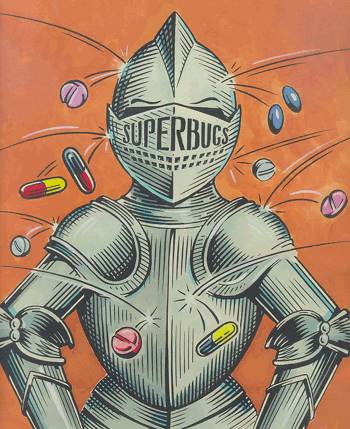Antibiotics have potentially saved more lives than any other human invention. During the 1940s-1970s, scientists discovered hundreds of new antibiotics, mainly from natural sources, with the best of these developed into drugs able to cure life-threatening infections. Much of this discovery was collaborative. Academic and industrial researchers worked together to help save lives. Unfortunately, bacteria have adapted so much that many antibiotics are no longer effective at killing them.

The microorganisms have evolved a range of ways to avoid their effects, and our ability to discover new antibiotics has not kept up with the bacteria’s ability to become resistant to existing therapies. We now have some infections which cannot be treated by any antibiotic, with patients dying. The scary reality is that these extremely drug resistant bacteria are becoming increasingly common, can readily share their resistance genes with other bacteria, and are being carried around the world by international travelers.
The traditional source of new antibiotics, the large pharmaceutical companies, have largely abandoned this area of research because it is hard to justify economically – they can sell a new anticancer therapy that prolongs a life for nearly $US100,000 per year, but are unable to charge little more than $US5000 for a 2 week course of antibiotics that can save a life.
We need new ways to discover new antibiotics. Antibiotics are different from many other types of drugs, and a lot of the rules developed over the last 20 years for drug discovery projects that focus on ‘drug-like’ properties mean that potential antibiotics might be discarded before they are even tested. The Community for Open Antimicrobial Drug Discovery (CO-ADD) is our attempt to develop a collaborative pipeline of new antibiotic candidates by mining the diverse chemical space of synthetic chemists around the world. Chemists make new molecules for all sorts of reasons, and many of these molecules have unusual structures. However, once made many compounds are either thrown away or just get stored on shelves and in fridges in the backs of labs, and are certainly never tested for antimicrobial activity.
With funding from the Wellcome Trust and support from the University of Queensland, CO-ADD is offering free testing to see if compounds can kill any one of five key pathogenic bacteria or two fungi. Importantly, whoever submits the compound keeps all the rights to publish or patent, and develop any promising compounds. CO-ADD will use the screening data to generate a publically accessible database to allow other scientists to see what types of molecules have antimicrobial activity and, just as importantly, what types don’t.
CO-ADD has had a great reception from the scientific community, with over 80 participating groups from 26 countries sending nearly 20,000 compounds in our first 8 months, with over 300,000 additional compounds promised. We’re currently running a ‘Thinkable’ competition to award novel ideals for submissions. It’s still too early to see whether we’ll discover the next antibiotic, but we’ve identified nearly 500 compounds with promising activity.
About the author: Dr. Mark Blaskovich is the Program Coordinator for Hit Validation & Chemistry for the Community for Open Antimicrobial Drug Discovery (CO-ADD, see www.co-add.org). He’s also a Senior Research Officer at the Institute for Molecular Bioscience at The University of Queensland in Australia.


